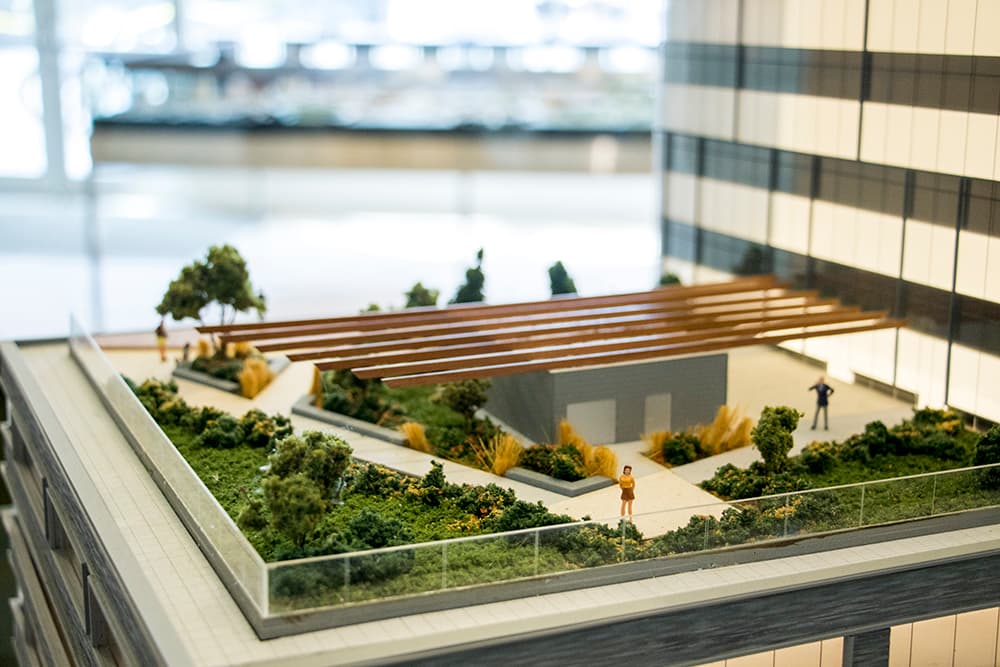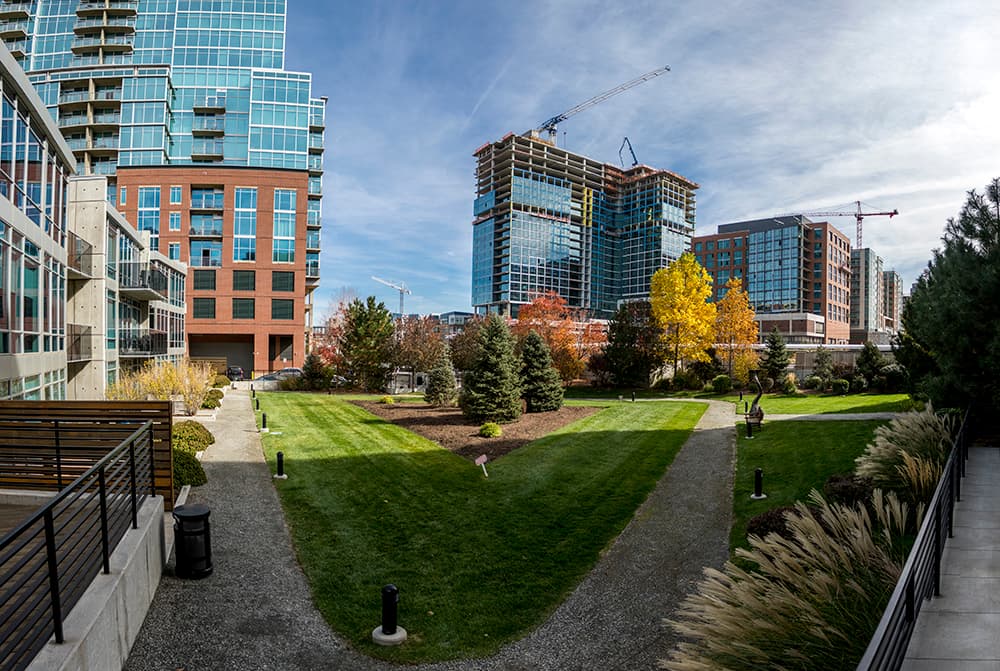
The Denver Green Roofs Initiative, on your 2017 ballot as Initiated Ordinance 300, would require that all buildings greater than 25,000 square feet dedicate a portion of their rooftop to green space or a combination of green space and solar panels. The larger the building, the larger the amount of rooftop that would need to be converted to vegetation.
Yes, this would cost more money than building standard roofs.
Proponents of the measure say that increased upfront cost will pay dividends down the road, in a longer lifespan for the roof, in energy efficiency of the building, in improved water quality for the region and in a reduced urban heat island effect.
Opponents say the cost will get passed on to the tenants in higher rents and make public projects more expensive. They say the ordinance as drafted is too burdensome, and people involved in construction and economic development weren't consulted first.
Here's what you need to know:
What does the ballot language say?
Shall the voters of the City and County of Denver adopt a measure that requires every building and any roof replacement of a building with a gross floor area of 25,000 square feet or greater, or a building addition that causes the building to become 25,000 square feet or greater, constructed after January 1, 2018, shall include a green roof or combination of green roof and solar energy collection; while also requiring proper permits and maintenance plans, establishing construction standards and a technical advisory group, and publishing construction guidelines and best practices; also allowing for exemptions and requiring enforcement with violations and penalties?
What would this initiative do?
If approved, all new roofs on larger buildings would have to include some green roof area. Buildings between 25,000 and 49,999 square foot would have to set aside 20 percent of the rooftop, buildings 50,000 to 99,999 square feet would have to set aside 30 percent and so on up to 60 percent for buildings 200,000 square feet and larger.
Residential buildings shorter than four stories or 50 feet would not be required to have green roofs. Building owners could also reduce the amount of green roof if they dedicated a certain amount of the rooftop to solar.
The owners of existing buildings could get a waiver and pay a fee in lieu of installing a green roof at the time of roof replacement if their building was not engineered to withstand the additional weight of a green roof.
You can read the entire ordinance here for the details.
What is a green roof? Why is a green roof?
Green roofs allow vegetation to grow on the roof. Green roof systems involve a waterproof roof membrane and root barrier, filter fabric, a drainage system, a growing medium (like soil) and plants. They can come in a modular set-up prepared in trays or each component can be installed on top of the building structure. Green roofs can be shallow or deep. The deeper the growing medium, the greater the range of plants that can be grown but also the heavier the roof will be.
Green roofs are supposed to come with a lot of benefits, both for the building and the environment. Because the roof membrane is not directly exposed to sun, snow, hail and so on, the roof should last substantially longer, and they make buildings more energy efficient. By soaking up rain water, they reduce runoff and improve water quality in surrounding areas. Green roofs also help reduce the urban heat island effect.
Has anyone else done this?
Toronto adopted a Green Roof Bylaw in 2009, and the Denver initiative follows it closely. Toronto also adopted a grant program to help offset the cost of adding green roofs to existing buildings. Denver's proposal does not include any financial assistance.
San Francisco adopted a green roof ordinance in October 2016, becoming the first U.S. city to take this step.
Green roofs are part of the stormwater management plan in Washington, D.C., to protect the Chesapeake Bay, and most large buildings have to have green roofs to be in compliance. Washington's program also includes financial incentives.
So Denver wouldn't be a lone pioneer, but it would be out in front in terms of major U.S. cities requiring green roofs.
Can you even do green roofs in a high desert climate like Denver?
Absolutely, says Leila Tolderlund, an assistant professor in the University of Colorado Denver's College of Architecture and Planning. Full disclosure: Tolderlund is a supporter of the measure. She's also an expert in green roofs and the author of the EPA's design guidelines and maintenance manual for green roofs in the semi-arid and arid West.
"We have a lot of extreme freeze/thaw cycles, and they really tear up roof membranes," Tolderlund said. "Materials that are rated for 12 to 15 years don't last that long here. ... When we put a living layer on top of a roof, it really changes that."
Maintaining green roofs in the West is a matter of choosing the right plants, Tolderlund said. There are green roofs at 1595 Wynkoop St., the office building that houses the EPA's regional headquarters, the Denver Botanic Gardens, the Ralph Carr Judicial Center, the parking garage at REI and One Riverfront, a large development in downtown Denver.

Scott Leggett, managing broker at Slifer Smith & Frampton, a real estate brokerage whose sister firm East West Partners developed One Riverfront, describes the green roof as "just a big planter box, essentially, a half-acre planter box" and a feature that has transformed what would have been the concrete pad of the parking structure's roof into a park amenity for residents.

How much would this cost?
Tolderlund said green roofs cost about 2.5 times more than conventional roofs to install, but they last four to five times longer and make buildings less expensive to run. Proponents of the initiative say most building owners would see a return on their investment in a little more than six years.
Opponents say the upfront cost of $25 to $30 a square foot is simply too high and will drive up rents for families and businesses. They estimate that a green roof requirement would add about $300,000 to the cost of a grocery store and $130,200 to the cost of the Carla Madison Recreation Center. (For context, that's a $60 million project.)
Visit Denver estimates the green roof requirement would add $15 million to $20 million to the cost of the expansion at the Colorado Convention Center, a project already facing serious cost overruns.
A cost-benefit analysis by the Green Infrastructure Foundation, on the other hand, predicted a net $1.85 billion in savings over the next 40 years if the measure passes.
Who supports this initiative?
Brandon Rietheimer, an environmental activist and self-employed maker and seller of lapel pins, got the ball rolling on this. He's working with people who install and maintain green roofs, like Andy Creath, president of Green Roofs of Colorado (that's a company, not an advocacy group).
Initiative 300 has been endorsed by the environmental group 350 Colorado and by the Colorado Native Plant Society.
Initiative backers had raised a little more than $6,000 as of the last reporting period, most of it in small donations from individuals.
Who opposes this initiative?
Citizens for a Responsible Denver, the committee formed to oppose the initiative, is made up largely of business and construction interests. Their list of opponents includes the Denver Metro Chamber of Commerce, the Downtown Denver Partnership, the Colorado Association of Mechanical and Plumbing Contractors, the Commercial Real Estate Development Association, Colorado Association of Realtors, Visit Denver and the Building Owners and Managers Association.
Most of the $41,450 the group had raised as of the last reporting period came from the Colorado Association of Realtors' political arm.
Denver Mayor Michael Hancock also came out against the initiative, saying it was "not the right approach for Denver" and "goes too far, too fast."

Can City Council make changes to this ordinance or get rid of it entirely?
Denver City Council must wait six months from the date of the election before amending or repealing an initiated ordinance, and any changes to an initiated ordinance require a two-thirds majority. There's obviously a political calculation that council members have to make when considering if they want to undo the will of the people, but it is within their authority.
That also means City Council can fix problems with the ordinance. One issue that's been raised already is that existing buildings might have to pay for an exemption every time the roof is replaced. Drafters say that was not their intention -- they were imagining existing buildings with constraints that make a green roof prohibitively expensive would just pay once -- and City Council could consider an amendment to clarify that language.
The ordinance also calls for the creation of a technical advisory board to establish the rules and regulations for implementing the ordinance. That's another place that vagaries and inconsistencies could be ironed out, provided the ordinance language is flexible enough.
Why did proponents do this as an initiated ordinance instead of asking Denver City Council to adopt a requirement?
Brandon Reitheimer, the organizer behind the Green Roofs Initiative, said that when he first started talking to city planners, he was told that Denver has a no-mandates policy when it comes to sustainability measures. That might not be the case forever, but the city has strongly preferred incentives and nudging.
Frustrated, Rietheimer decided to go the initiated ordinance route and collected signatures to place the measure on the ballot. Now it's up to the voters.
"I tried to reach out, and I just got the door shut in my face. We felt this needed to be done now, not 10 years from now, not five years from now," Rietheimer told a City Council committee earlier this month.
According to opponents, though, this is exactly the wrong way to do a major policy change. A city process would have involved stakeholder groups, multiple rounds of feedback and compromises between environmental benefit and economic concerns.
In his statement, Hancock suggested that would have been a better approach.
"By taking a mandate-only approach and eliminating the opportunity for options, the initiative would actually hinder efforts to pilot, promote, phase and incentivize green infrastructure, as is being done in many of our peer cities across the United States," he said.











